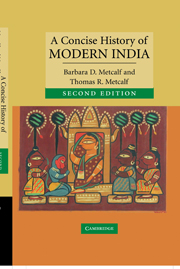Book contents
- Frontmatter
- Contents
- List of illustrations
- Preface to the second edition
- Preface to the first edition
- Glossary
- Chronology
- 1 Sultans, Mughals, and pre-colonial Indian society
- 2 Mughal twilight: the emergence of regional states and the East India Company
- 3 The East India Company Raj, 1772–1850
- 4 Revolt, the modern state, and colonized subjects, 1848–1885
- 5 Civil society, colonial constraints, 1885–1919
- 6 The crisis of the colonial order, 1919–1939
- 7 The 1940s: triumph and tragedy
- 8 Congress Raj: democracy and development, 1950–1989
- 9 Democratic India in the nineties: coalitions, class, community, consumers, and conflict
- Epilogue: a new century begins
- Biographical notes
- Bibliographic essay
- Index
- CAMBRIDGE CONCISE HISTORIES
4 - Revolt, the modern state, and colonized subjects, 1848–1885
Published online by Cambridge University Press: 05 June 2012
- Frontmatter
- Contents
- List of illustrations
- Preface to the second edition
- Preface to the first edition
- Glossary
- Chronology
- 1 Sultans, Mughals, and pre-colonial Indian society
- 2 Mughal twilight: the emergence of regional states and the East India Company
- 3 The East India Company Raj, 1772–1850
- 4 Revolt, the modern state, and colonized subjects, 1848–1885
- 5 Civil society, colonial constraints, 1885–1919
- 6 The crisis of the colonial order, 1919–1939
- 7 The 1940s: triumph and tragedy
- 8 Congress Raj: democracy and development, 1950–1989
- 9 Democratic India in the nineties: coalitions, class, community, consumers, and conflict
- Epilogue: a new century begins
- Biographical notes
- Bibliographic essay
- Index
- CAMBRIDGE CONCISE HISTORIES
Summary
The revolt of 1857–8, which swept across much of north India in opposition to British rule, has conventionally been taken as the dividing point that marks the beginning of modern India. Historical periodization is, however, always somewhat arbitrary. With greater distance from the colonial period, when the searing chaos of the uprising was understood either as ‘Mutiny’ to the colonial rulers or as the ‘First War of Independence’ to many nationalists, it is possible to focus on substantial, long-term transformations rather than on a single event. Such an emphasis, moreover, places India in the context of changes taking place in the larger world, not just in terms of events and personalities in India itself. Far from modernity ‘happening’ in Europe and then being transplanted to a country like India, many of these changes took place in relation to each other.
Modern technological changes, among them canals, railways, and telegraph, were introduced into India within years of their introduction in Europe. Changes essential to the modern state, including the unification of sovereignty, the surveying and policing of the population, and institutions meant to create an educated citizenry were also, broadly speaking, introduced during the same period in India and in parts of Europe. Indeed, certain modern practices and institutions were either stimulated by the Indian experience or originated in India itself. Municipal cemeteries, as noted above, appeared in India before they did in England; the same is true of English literature as a curricular subject, and of state-sponsored scientific and surveying institutions.
- Type
- Chapter
- Information
- A Concise History of Modern India , pp. 92 - 122Publisher: Cambridge University PressPrint publication year: 2006

